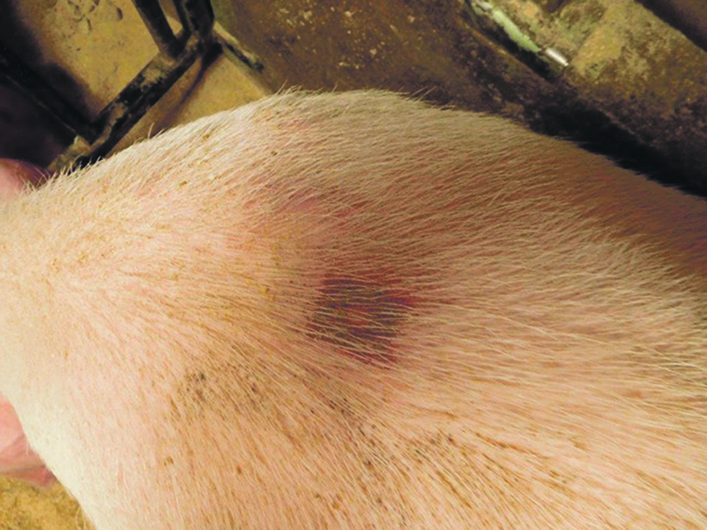Living in Western Canada has its advantages.
We have space, fresh air, clean water and few skin diseases that affect our modern pig farms. Not everyone appreciates that last one.
Our western Canadian approach to managing the pigs’ environment, farm biosecurity and preventive health management programs in modern pig farms reduces many health challenges that other countries struggle with.
We have all heard that the skin is the largest organ of the body, which is true, in addition to being an important immune barrier to many diseases. Pig skin is commonly used in the textile industry and is an important part of the pork value chain.
Here are a few health challenges that manifest as skin disease in our modern herds.
Erysipelas (diamond skin)
Erysipelas is a bacterial condition that has the clinical sign of diamond-shaped skin lesions over the shoulders, back and sides of the pig.

The bacteria (Erysipelothrix rhusiopathiae) circulate throughout the body, causing high fever, lethargy and in rare instances arthritis. The skin lesions can cause scarring, once healed, impacting carcass quality at the packing plant where the scars must be trimmed off.
Vaccinations can easily eliminate the disease.
The bacteria is soil-borne, so the disease has become less common as pig production moved indoors.
Once pigs have become infected and show clinical signs, Erysipelas is treated with penicillin and anti-inflammatories for the fever.
Porcine dermatopathy and nephropathy syndrome (PDNS)
Porcine circovirus type 2 (PCV2) has been one of the most detrimental viral challenges I have seen. PCV2 infects the pig’s immune system, causing pigs to waste away and mortality to reach 40 percent in some cases.
Read Also

Beef check-off collection system aligns across the country
A single and aligned check-off collection system based on where producers live makes the system equal said Chad Ross, Saskatchewan Cattle Association chair.
One of the clinical manifestations of PCV2 infection beyond wasting disease is a condition where immune complexes (antibody-antigen complexes) are deposited in high levels in the skin and kidneys.
The accumulation of these complexes leads to microvascular damage in the skin, subsequently becoming scabbed and then necrotic.
Unfortunately, these pigs also have irreversible kidney damage and individual mortality is very high.
Many effective PCV2 vaccines are available, which have led to very good control of these circovirus diseases.
When we see a PDNS pig today, we usually suspect the pigs have missed their PCV2 vaccination.
Greasy pig disease
Greasy pig is another bacterial skin infection that can lead to dramatic health challenges on some farms, typically impacting first parity (gilt) litters.
Greasy pig (exudative dermatitis caused by Staphylococcus hyicus) is most often found in suckling pigs. As piglets jostle for teat space and milk at feeding times, they scratch each other’s faces with their razor sharp teeth. The broken skin allows the Staph bacteria access to begin colonizing and multiplying in the wounds, inducing fluid exudate from the injured skin. Greasy pig is characterized by spots or scrapes that become thickened and exude fluid, giving the skin a greasy appearance.
The greasy skin is wet and affected pigs become chilled. The chilled pig’s skin response is to grow more hair.
If found early in the disease process, pigs can be treated with antibiotics and mineral oil can be applied to coat the skin, preventing further bacterial colonization.
Prevention of greasy pig often involves application of zinc cream (any diaper cream will do) on scratched faces.
Years ago, it was common for piglets to have their needle teeth trimmed at birth to reduce face scratching. In modern pig production we leave teeth alone and really focus on lactation quality to ensure new-born piglets don’t fight for teat space and milk, reducing the face scratches.
Pityriasis rosea
This skin condition is not common, but interesting in that we don’t understand the cause. Some suspect there is a hereditary component being observed more in landrace breeds.
Pityriasis appears in young growing pigs between 15 and 25 kilograms as raised red patches of skin over the legs, rump and back coalescing into larger patches. The centre of the skin lesions returns to normal-appearing skin and eventually disappears altogether. No treatment is necessary.
Mange
Modern pig farm biosecurity practices, including rearing pigs indoors, has essentially eliminated external parasites like mange and lice. In 20 years, I have seen mange twice, and in both cases, we implemented elimination strategies to eradicate the mange mites.
These are a few of the skin conditions we continue to see on modern pig farms. Gone are the days of sun burns, severe mosquito bites, frostbite, and other skin conditions that would affect outdoor-raised pigs.
Special thanks to the American Association of Swine Veterinarians Image Library for these skin lesion pictures.
Blaine Tully is a veterinarian and owner of Swine Health Professionals Ltd. in Steinbach, Man.

















